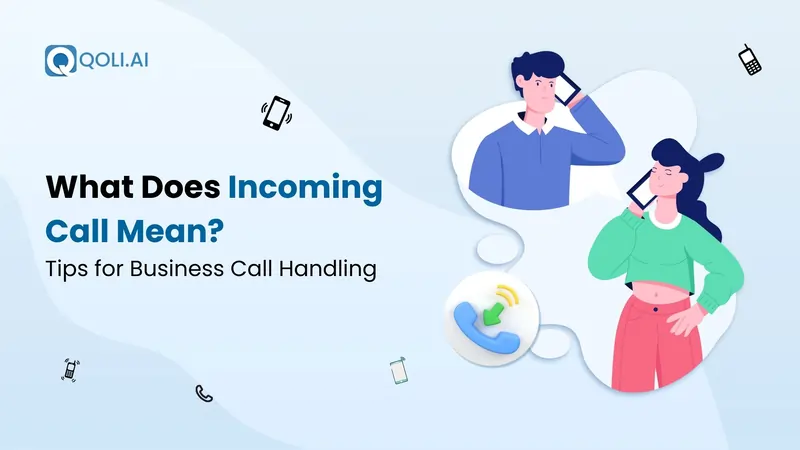What Does Incoming Call Mean in Business: Types & Features
An incoming call is any call received from an outside number. Understand its types, features, routing, and role in business to manage every call efficiently.
Author: Sujith Grandhi
An incoming call is any call received from an outside number. Understand its types, features, routing, and role in business to manage every call efficiently.
Author: Sujith Grandhi

In business, every call counts. Some calls bring in new clients, others solve urgent problems, and some keep your team connected. An incoming call is simply a phone call your business receives from an outside number and handling it efficiently can make or break customer experience.
From small businesses to large enterprises, understanding what an incoming call is, its types, how it’s routed, and the features that help manage it ensures you never miss an opportunity. This guide breaks it all down clearly, so you can handle every call like a pro and keep your operations running smoothly.
An incoming call is simply any call you receive from an outside number. It’s the call someone makes to reach you, whether it could be a friend, family member, service provider, or a customer trying to reach your business.
Unlike outgoing calls, which you initiate, incoming calls are all about the person on the other end reaching out to you. And in business, how you handle these calls matters a lot, it can affect customer satisfaction, lead generation, and even your brand reputation.
Think of it this way: every incoming call is an opportunity, an opportunity to solve a problem, provide support, or turn a curious caller into a loyal client.
An incoming call has several defining features that make it distinct:
In a business context (commonly referred to as inbound calls), incoming calls often exhibit additional characteristics:
Incoming calls can vary depending on the purpose and the context. Understanding the types helps you manage them effectively, whether it’s for personal use or business. Here are the main categories:
In short, incoming calls can serve many purposes, from personal connections to critical business interactions, and knowing the type helps you respond the right way.
The main difference lies in who starts the call.
Think of it this way:
It’s simple but important. An incoming call is received by your business, while an outgoing call is initiated by you. Both play vital roles but serve different purposes: incoming calls often relate to support or leads, while outgoing calls are typically proactive, like following up with clients or making sales calls.
| Feature | Incoming Call | Outgoing Call |
|---|---|---|
| Initiated by | External caller | You or your business |
| Purpose | Customer support, inquiries, alerts | Sales, follow-ups, notifications |
| Control | You receive it and respond | You decide when and who to call |
| Cost | Usually free for the receiver | May incur charges for the caller |
Both are essential in personal communication and business. Incoming calls help you listen and respond, while outgoing calls let you take the initiative and connect on your terms.
Incoming calls rarely go straight to a person. Most businesses use call routing systems to ensure each call reaches the right destination efficiently.
For example, a customer dialing your support line may first encounter an IVR menu asking them to press 1 for tech support or 2 for billing. The system then routes the call to the available agent.
Tips for Handling Incoming Calls
Modern business phone systems come with features designed to make incoming calls more manageable:
These features help your team stay organized, respond promptly, and maintain a professional image.
Incoming calls are direct lines to your audience. They are opportunities to provide support, generate leads, and reinforce your brand. Efficiently handled calls lead to higher customer satisfaction, better conversion rates, and smoother internal operations. Studies show that businesses answering calls quickly are more likely to convert leads and resolve issues faster. In fact, most call centers aim to answer 80% of calls in under 20 seconds. But go slow, and customers may abandon, the ideal abandonment rate stays below 5%.
This is where Qoli makes a difference. With complete call log monitoring, businesses can see every incoming call in detail, missed, answered, or forwarded. On top of that, real-time monitoring, call recording, history tracking, and instant alerts help teams stay accountable and resolve issues faster. Qoli ensures no customer interaction slips through the cracks, turning every incoming call into a chance to build stronger relationships and grow your business.
Even the best systems can have hiccups. Common reasons for failed incoming calls:
Regular testing of your phone system and updating contact lists can prevent most of these issues.
For most businesses, incoming calls are free, you only pay if using premium services or toll-free numbers with specific arrangements.
Understanding the costs helps manage budgets and decide on using local or toll-free numbers.
Incoming calls may seem simple, but they play a big role in both personal and business communication. From casual chats with friends to customer support in call centers, every incoming call is a chance to connect and respond.
For businesses, the way these calls are handled can shape customer satisfaction, build trust, and even drive growth. For individuals, it’s about staying connected and informed.
In the end, an incoming call is more than just a ring, it’s an opportunity waiting on the other end.
Thank you for reading!😊